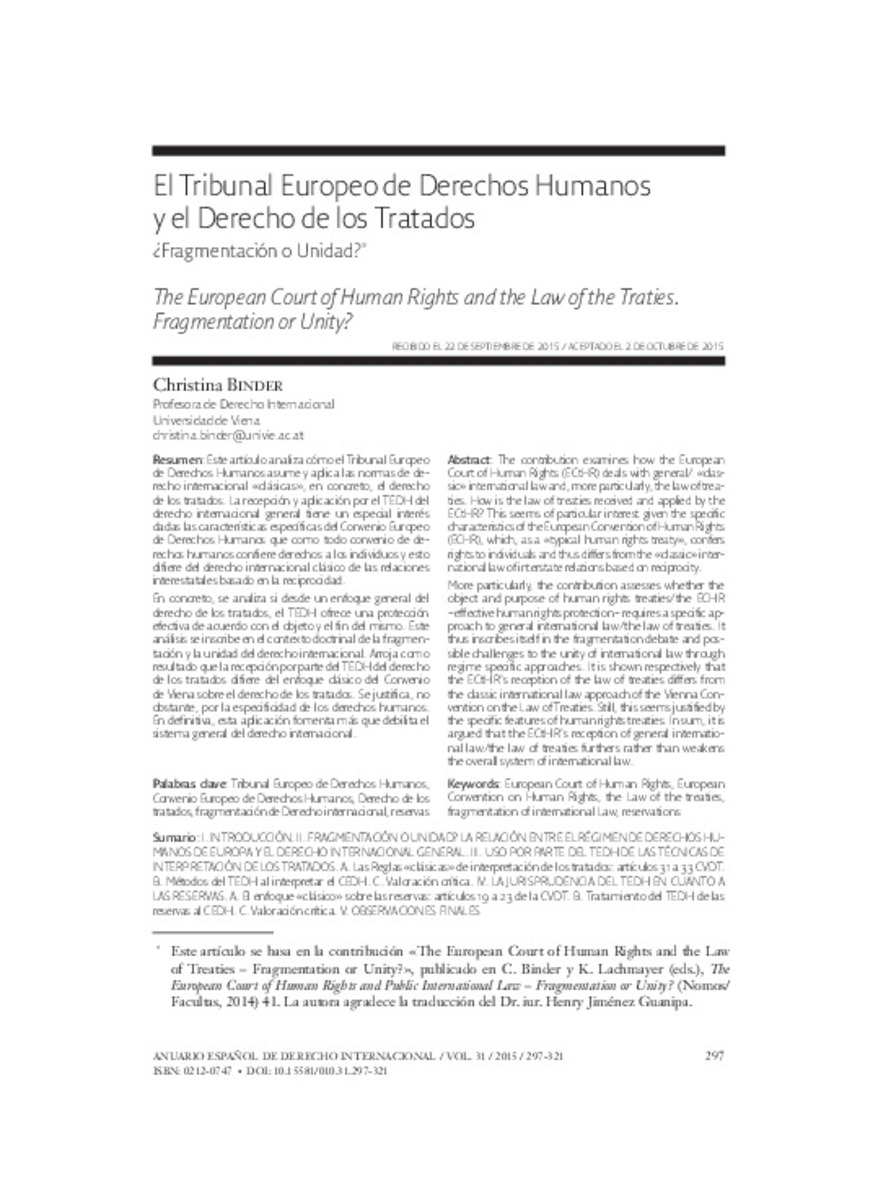Full metadata record
| DC Field | Value | Language |
|---|---|---|
| dc.creator | Binder, C. (Christina) | - |
| dc.date.accessioned | 2016-11-17T09:37:51Z | - |
| dc.date.available | 2016-11-17T09:37:51Z | - |
| dc.date.issued | 2015 | - |
| dc.identifier.citation | Binder, C. (2015). El Tribunal Europeo de Derechos Humanos y el Derecho de los Tratados, ¿Fragmentación o Unidad?. Anuario Español de Derecho Internacional 31, pp. 297-321 | es_ES |
| dc.identifier.issn | 0212-747 | - |
| dc.identifier.uri | https://hdl.handle.net/10171/42262 | - |
| dc.description.abstract | Este artículo analiza cómo el Tribunal Europeo de Derechos Humanos asume y aplica las normas de derecho internacional «clásicas», en concreto, el derecho de los tratados. La recepción y aplicación por el TEDH del derecho internacional general tiene un especial interés dadas las características específicas del Convenio Europeo de Derechos Humanos que como todo convenio de derechos humanos confiere derechos a los individuos y esto difiere del derecho internacional clásico de las relaciones interestatales basado en la reciprocidad. En concreto, se analiza si desde un enfoque general del derecho de los tratados, el TEDH ofrece una protección efectiva de acuerdo con el objeto y el fin del mismo. Este análisis se inscribe en el contexto doctrinal de la fragmentación y la unidad del derecho internacional. Arroja como resultado que la recepción por parte del TEDH del derecho de los tratados difiere del enfoque clásico del Convenio de Viena sobre el derecho de los tratados. Se justifica, no obstante, por la especificidad de los derechos humanos. En definitiva, esta aplicación fomenta más que debilita el sistema general del derecho internacional. | es_ES |
| dc.description.abstract | The contribution examines how the European Court of Human Rights (ECtHR) deals with general/ «classic» international law and, more particularly, the law of treaties. How is the law of treaties received and applied by the ECtHR? This seems of particular interest given the specific characteristics of the European Convention of Human Rights (ECHR), which, as a «typical human rights treaty», confers rights to individuals and thus differs from the «classic» international law of interstate relations based on reciprocity. More particularly, the contribution assesses whether the object and purpose of human rights treaties/the ECHR –effective human rights protection– requires a specific approach to general international law/the law of treaties. It thus inscribes itself in the fragmentation debate and possible challenges to the unity of international law through regime specific approaches. It is shown respectively that the ECtHR’s reception of the law of treaties differs from the classic international law approach of the Vienna Convention on the Law of Treaties. Still, this seems justified by the specific features of human rights treaties. In sum, it is argued that the ECtHR’s reception of general international law/the law of treaties furthers rather than weakens the overall system of international law. | es_ES |
| dc.language.iso | spa | es_ES |
| dc.publisher | Servicio de Publicaciones de la Universidad de Navarra | es_ES |
| dc.rights | info:eu-repo/semantics/openAccess | es_ES |
| dc.subject | reservas | es_ES |
| dc.subject | fragmentación de Derecho internacional | es_ES |
| dc.subject | Derecho de los tratados | es_ES |
| dc.subject | Convenio Europeo de Derechos Humanos | es_ES |
| dc.subject | Tribunal Europeo de Derechos Humanos | es_ES |
| dc.title | El Tribunal Europeo de Derechos Humanos y el Derecho de los Tratados, ¿Fragmentación o Unidad? | es_ES |
| dc.title.alternative | The European Court of Human Rights and the Law of the Traties. Fragmentation or Unity? | es_ES |
| dc.type | info:eu-repo/semantics/article | es_ES |
| dc.identifier.doi | 10.15581/010.31.297-321 | es_ES |
Files in This Item:
Statistics and impact
Items in Dadun are protected by copyright, with all rights reserved, unless otherwise indicated.






